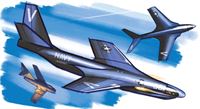
Описание
Страна : США
Год : 1949
Летающая лодка (проект)
Фотографии
-
Aviation Historian 25 / M.Willis - From Skate to Sea Dart (1)
A Convair technician prepares a scale model of one of the later Skate iterations, possibly the Skate 6 or 7, for alighting trials at the manufacturer’s water-testing facility at San Diego. Butterfly tails had been extensively tested on various Skate configurations up to and including the Skate 5, but conventional tails were fitted to models of Skates 6, 7 and 9.
-
Aviation Historian 28
LEFT The 1/80th-scale half-model of Convair’s Skate 9 attached to the transonic bump in NACA Langley’s high-speed windtunnel - the bump accelerated the airflow to the required speeds. This explains the odd, curved plan-view centreline on the drawing.
-
Aviation Historian 25 / M.Willis - From Skate to Sea Dart (1)
Members of the public inspect various Skate models during an open day in San Diego. Nearest the camera is the Skate 1, based loosely on the XB-46. Beyond that is the Skate 9, later redesignated Y2-1. Looking like a Supermarine Swift or Saab Lansen is the Skate 4, with two earlier Skate iterations, one with a V-tail, at the far end
-
Aviation Historian 25 / M.Willis - From Skate to Sea Dart (1)
By the summer of 1949 Convair had moved on to research into a subsonic waterborne attack aircraft, resulting in the Cudda, the first iteration of which is seen here with hull-step. Wingtip floats were also tested, as seen at LEFT. The Cudda No 2 (RIGHT) incorporated a hydro-ski arrangement and a conventional tail.
-
Aviation Historian 25 / M.Willis - From Skate to Sea Dart (1)
The Cudda No 3 was a development of the No 2, and incorporated a cockpit and a revised hull with chine strips. The full-scale 112ft 3in (34-2m)-long version was to have had a span of 88ft 8in (27m), with a wing area of 1,122ft2 (104-2m2). The prospective powerplant was a pair of Westinghouse XJ40-WE-14 afterburning turbojets.
-
Aviation Historian 25 / M.Willis - From Skate to Sea Dart (1)
Splash one MiG! A speculative impression of a butterfly-tailed, prone-pilot, single-engined Skate 2 variant in action with the US Navy in the skies over Korea.
-
Авиация и Время 2017-02 / А.Чечин - Дротик ядерного века (летающая лодка Sea Dart)
Проект летающей лодки «Скат»
-
Aviation Historian 25 / M.Willis - From Skate to Sea Dart (1)
A contemporary cutaway illustration of a later iteration of the Skate, in which the crew is accommodated side by side, but with the radar operator seated lower within the fuselage; the pilot’s canopy is offset to port, providing a downward field of vision of 20° from the horizontal to starboard and 42° to port.
-
Aviation Historian 25 / M.Willis - From Skate to Sea Dart (1)
A contemporary Convair illustration showing how the XB-46 design provided the basis for the first iteration of the Skate, with the removal of the wing-mounted pods containing the engines, and the latter’s relocation within a revised blended hull.
Другие самолёты на фотографии: Convair B-46 - США - 1947
-
Aviation Historian 25 / M.Willis - From Skate to Sea Dart (1)
A 1951 impression of one of the later Skate iterations, emphasising the virtues of the seaplane fighter, even suggesting that engine changes could be made on the water without the need for a support vessel
-
Aviation Historian 25 / M.Willis - From Skate to Sea Dart (1)
A NACA drawing of the 1/80th-scale model of the Skate 9, with all dimensions in inches (and a curiously curved plan-view centreline). The Skate 9, the final configuration for the Skate concept study, a nightfighter version of which was designated Y2-1, had an estimated top speed of 640 m.p.h. (1,030km/h) at 35,000ft (10,700m).
-
Aviation Historian 25 / M.Willis - From Skate to Sea Dart (1)
Convair’s water babies Skate to Sea Dart, 1946-52
Другие самолёты на фотографии: Convair F2Y Sea Dart - США - 1953












